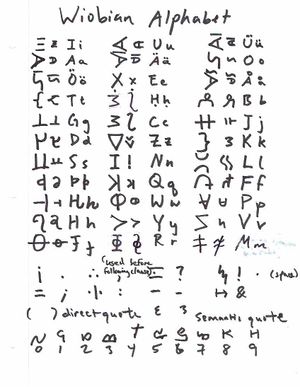Altwiebisch/Script
Wiobian is written in a native alphabet named Trabe&Galster after the first two letters Trabe and Galst, also used to write other languages such as Whetmerish and Cuatham. The spelling rules reflect Classical Wiobian pronunciation; subsequent sound changes have made the relationship between orthography and pronunciation more opaque. The transliteration of Wiobian used in this article attempts to reflect the Wiobian orthographical spelling standardized near the end of the Classical Wiobian period and re-standardized in the modern period in 1811 v.C. using classical texts and internal reconstruction from Wiobian topolects (especially utilizing Whetmerish, known for its conservatism in unstressed prefixes). Another factor in the orthography is that literacy was limited to the upper class. Thus often the elites spoke one language while writing in a fossilized form of the language, so that e.g. case endings were still written even after most of them dropped out in the spoken language. The Classical Wiobian they wrote was, however, written in the stricter syntax of the vernacular.
Modern Standard Wiobian employs consonant alternations triggered by originally unstressed prefixes. One difficulty is that originally unstressed prefixes often don't change a word's pronunciation anymore, because the particular initial consonant is immune to the mutation caused by the prefix:
- mezz - 'wait'
- bemezz - 'long for'
are both pronounced /məi̯k˥/. The homophony was solved by compounding nouns and verbs with other words to disambiguate them, creating a wealth of compounds, as in Chinese.
Letter names
Most letter names for consonants are derived from Primitive Tergetian. Vowels, on the other hand, use the vowel itself as the name.
- T: Trabe < *tenābōˀ 'jaws'
- G: Galst < *gałṭom 'ground'
- K: Kohl < *kōllom 'bird'
- I
- W: Wier < *wiˀrom 'head'
- N: Narch < *narakom 'cascade'
- U
- Ü
- Q: Kried < *qarīdis 'coast'
- L: Lecken < *leqnom 'river'
- P: Pfut < *pūtom 'ox'
- C: Ang < *ˀangom 'face'
- E
- Ŧ: Ŧeib < *ƛeybom 'harp'
- J: Jamm < *yanpom 'house' (Modern Tergetian ˀáb)
- F: Fitt 'worm'
- O
- Ö
- M: Mersch < *merśom 'flag'
- D: Dachel < *daklom 'tree'
- Đ: Đruche < *đirūkōs 'lips'
- R: Rift < *ripṭom 'throat'
- S: Schnade < *łinādōs 'gates'
- H: Hammel < *hamlom 'flower'
- B: Bruog < *barōgom 'knot'
- ß: Descherschnader 'two Schnade's'
- Z: Zamm < *cammom 'paw'
- A
- Ä
- Å
Capitalization
Wiobian orthography has capital and lowercase letters. Wiobian capitalizes all nouns, but not necessarily words that are in the beginning of the sentence; this is reflected in the Romanization.
Punctuation
The Lusk-Frann ("binding mark") is a hyphen-like symbol used to link genitive nouns to their heads. It is transcribed with a hyphen (-).
The Je-Hust ("je-space"), also called the serializer in English, is used to link coordinated components in compounds and serial verbs. As its name suggests, it also indicates a missing je ('and') in poetry. The serializer is transcribed with an ampersand (&).
